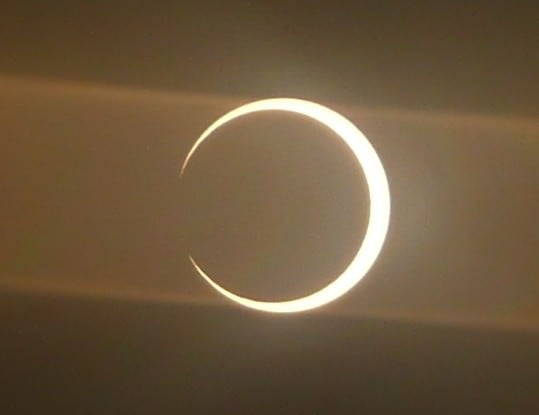Caption: Annular solar eclipse on January 15, 2009. Courtesy Daniel Fischer, " cosmos4u" on Twitter.
The first of two solar eclipses to occur in 2010 took place Friday, January 15. This was an annular eclipse, which means the Sun was not totally covered by the Moon, creating a "ring of fire." The eclipse was visible from a 300-km-wide track that passed over central Africa, across the Indian Ocean, over the southern tip of India and the northern end of Sri Lanka, and then across parts of Bangladesh and Myanmar. At the center of the track, the eclipse endured for 11 minutes and eight seconds, setting a record that won't be beaten until December 23, 3043. Weather cooperated in many regions, allowing good viewing conditions. Here are a few images and videos from
Daniel Fischer
, who was in Varkala, India, and another group who calls themselves
Eclipse Hunt 2010 crew
were in Jaffna, Sri Lanka. The image above is from Fischer, who said
via Twitter
that his travels to view the eclipse was a total success. "Deep blue sky, not a single cloud all day, photo plans worked."
[caption id="attachment_51290" align="alignnone" width="500" caption="Annular eclipse, Jan 15, 2010 by Shehal Joseph and Romayne Anthony. Courtesy Elipse Hunt 2010 website"]
[/caption]
This image is from the Eclipse Hunt 2010 crew, in northern Sri Lanka. It was taken by Shehal Joseph and Romayne Anthony. They used a Celestron NexStar 5se telescope with a focal length of 1.25m, and an energy rejection filter.
Why the "ring of fire?" During an annular eclipse, the moon is a little further than average away from the earth and its angular size in the sky is therefore slightly smaller than the angular size of the sun. So it is like the Moon is silhouetted against the Sun, and it doesn't cover the Sun entirely. A a ring, or annulus, of sunlight can be seen around the black disk of the moon.
[caption id="attachment_51291" align="alignnone" width="580" caption="The Moon casts a shadow on Earth, as seen by NASA's Aqua satellite from space. Credit: NASA"]
[/caption]
NASA's Aqua satellite was looking down from space at 1:15 p.m. Calcutta time (7:45 UTC) on January 15, 2010, and saw the Moon's shadow cast on Earth. The Moderate Resolution Imaging Spectroradiometer (MODIS) on Aqua images this shadowed area in India and the Bay of Bengal. The shadow spanned a north-south distance of about 300 kilometers (185 miles) on the surface, with the darkest part near the mid-point of the span.
[caption id="attachment_51293" align="alignnone" width="580" caption="The Sun's chromosphere was visible in a long exposure. Credit: T. Kampschulte"]
[/caption] This is another image from the
Fischer's
group of astrophotographers in India. By taking a long-exposure image, the sun's
chromosphere
was able to be seen.
Normally with an annular eclipse, not a lot of science is able to be done, said Jay Pasachoff, who leads the IAU's working group on eclipses. "Because it doesn't get completely dark, we won't be able to see the solar corona, the diamond ring, or the fantastically interesting and beautiful phenomena that one sees at a total solar eclipse, but still annular eclipses are interesting to see," Pasachoff said on the
365 Days of Astronomy podcast.
"You have to keep a solar filter on to look through for the whole time. The partial phases that last an hour and a half and the annular phase, which, for this eclipse, lasts, in many places, over ten minutes - very long for an eclipse."
Interestingly, the images shown here by Fischer's group used a very low-tech combination of a compact camera and their filters were two "rescue sheets," the thin aluminum foil-like thermal blankets usually given out during emergency situations, such as the recent earthquake in Haiti.
The Eclipse Hunt 2010 crew took a few videos of the eclipse, using the projection method.
See more of their videos here at their You Tube page.
And see more images on
their website, Eclipse 2010.
Special thanks to Prasanna Deshapriya, one of the members of the Eclipse Hunt 2010 crew, who shared these images. Check out
his website about the IYA in Sri Lanka.
[caption id="attachment_51304" align="alignnone" width="580" caption="A high resolution image from a telescope in India. Credit: T. Kampschulte"]
[/caption]
This high-resolution image obtained using a telescope was taken by Fischer's group in India. "The Ring of Fire is closed, but just barely; it measures a few arc seconds only in places in this super-sharp telescopic image," said
Fischer, via Twitter
.
For more eclipse images go to:
Spaceweather.com's eclipse gallery
Flickr's eclipse thread
More eclipse videos on You Tube
More links to the eclipse can be found here.
Plus, the
Jan. 18 Astronomy Picture of the day is from the eclipse.
The next solar eclipse will be a total eclipse, on July 11th, 2010. "That won't be seen by very many people at all," said Pasachoff. "It is largely over the Pacific Ocean, where it will cross some normally uninhabited atolls not far from Tahiti, so there'll be some ships there and some few expeditions out of Tahiti to see that. The major land in the way is a very unusual island, Easter Island. It's in the middle of the Pacific, some 4,000 miles west of the coast of Chile."
But, Pasachoff will be there.
 Universe Today
Universe Today
